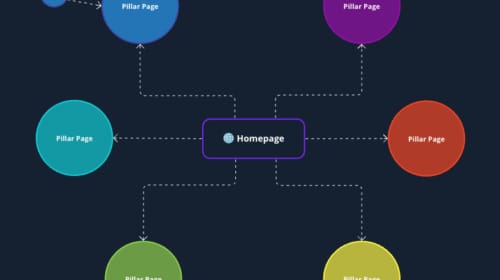What are the main types of SEO?
When trying to figure out where to start with SEO, it’s important to not only know and understand the different types of SEO, but it’s important to know the process and how to work through each type of core pillar.
Technical SEO
When thinking of SEO, envision your website to be a car and the technical SEO tactics make up the engine. When conducting a technical SEO analysis, we are “checking under the hood” of a website to make sure that the website doesn’t just look good from the outside but will be able to run properly.

Examples of technical SEO tactics:
- Indexing strategy
- Page speed
- Broken pages
Site Architecture
- UX
- Click depth (making sure your most important pages are easy to find)
On-page SEO
If technical SEO is the engine of a website, then the content is the gasoline that drives the engine. We must keep pumping content to really get mileage out of our website performance. The mileage in this case would refer to how many keyword rankings and how many organic search results a website can achieve in Google.
- Keyword research
- Keyword Intent
- Keyword Difficulty
- Average Monthly Search Volume (MSV)
- Title tag & meta description optimisations
- Topic modelling and web copy optimisations
- Content Strategy
- Keyword focused content clusters
- Internal linking strategies
Related content: Complete SEO Glossary for Beginners
Off-Page SEO
Off-page tactics is also known as link building. These tactics increase the authority of a website and are still important to Google when it comes to deciding what website contains the best information for the user. But beware, engaging in any link schemes goes against Google’s best practices and is known in the industry as “black hat” tactics. If you’ve hired an SEO expert in the past that engaged in these tactics, you may need to remove those links. That process is known as a “back link detox.”
- Strategic backlink acquisition
- Toxic backlink removal campaigns
Understanding the SEO Process
Take these four types of SEO and put together an SEO process that prioritises the most important ranking factor in each core pillar of SEO. Breaking down teh pillars and applying the process demystifies and empowers your team to achieve higher rankings and increase organic traffic.
Top SEO tactics in each core pillar:
-
Competitor Keyword Ranking Analysis
Before starting your SEO campaign, it’s good to know where you stand against your competitors. You can use an SEO tool like SEMrush to pull keyword rankings of your competitors to find what keywords they are targeting versus what keywords your website is rankings for. This is one way to conduct keyword research and find relevant keywords for new content topics to write about for your blog or create some new web pages.
-
Keyword Mapping
Keyword mapping is the SEO process where you assign a keyword to a particular page and compose a title tag and meta description all within specific character limits defined by Google. Yoast is a great SEO tool to help you compose title tags and meta descriptions within those character limits.
-
On-Page Optimisations
On-page optimisations include adding structured H1 and H12 headers with relevant keywords, keyword phrases, and topics into your web pages. Other on-page SEO tactics include internal linking, CTAs, adding images, image alt tags, and videos.
-
Content Cluster Creation and Internal Linking
A content cluster is a group of blog topics that are related to each other and explain or educate a user around a specific product or service offering. These content clusters should all be linked together to create signals to Google and to build a websites expertise and authority of a specific topic or search term they want to own in Google search.
-
External Link Building
Avoid black hat link building schemes, because Google may penalise you with a spam flag. Instead, conduct some good ol’ fashioned backlink outreach. Another tactic is to create content that is so good that other websites will want to link to it. That SEO tactic is called creating “linkable assets.”
-
On-going Analysis and Optimisations
Think of your SEO efforts as routine engine maintenance. To keep your car (aka your website) chugging along at peak performance, you need to get oil top ops and tinker with certain engine parts. An SEO campaign needs constant analysis and optimisations to help keep your website rankings driving full speed ahead.
Other SEO Industry Term Examples
There are some other SEO industry terms to be aware of that aren’t specific types of SEO but should be differentiated so you know how they fit in.
- White SEO refers to SEO tactics that are by Google’s best practices and are not trying to “game the system.” White SEO tactics includes the major pillars mentioned above.
- Black hat SEO are SEO techniques that are considered to go against Google’s best practices. Examples of Black hat SEO would be keyword stuffing, engaging in link building schemes, cloaking, and more. Some marketers accidentally engage in these SEO tactics not knowing and that can have a negative effect. This negative effect on the website is referred to as negative SEO.
- Grey hat SEO is a term that defines SEO tactics as something in between white hat SEO and black hat SEO.
Black hat and grey hat tactics are not recommended at all. Stick to white hat SEO and Google’s best practices as best you can to avoid any penalties from Google.
Keen to power up your performance marketing? Sign up for our complimentary SEO or website audit. Check out our performance marketing services here.




